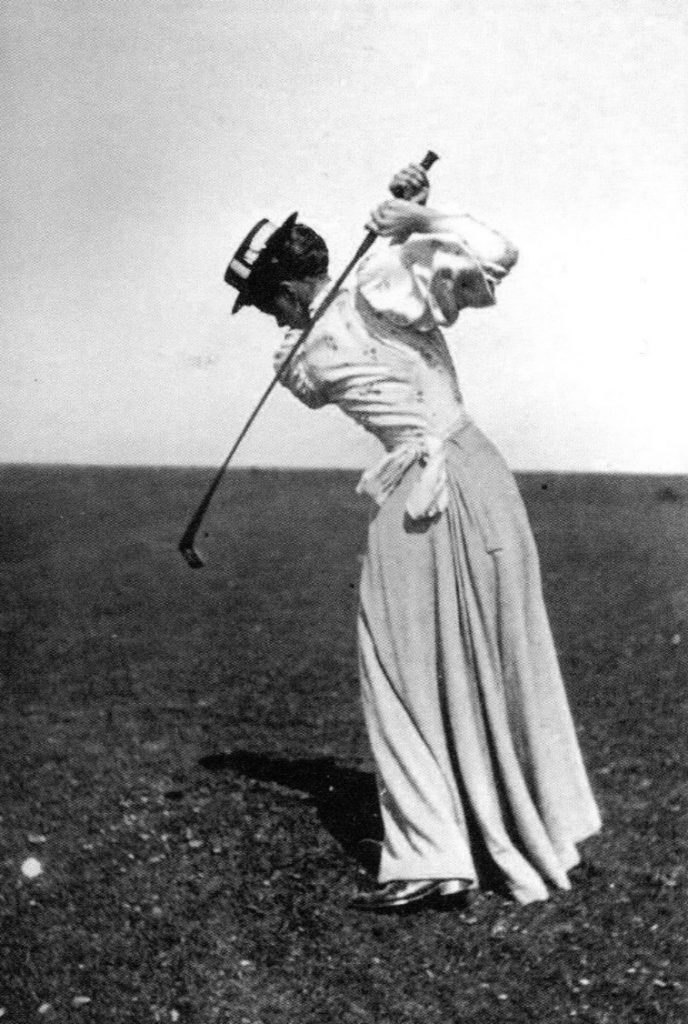While there is evidence that the wives of Musselburgh fishermen played in a golf competition in 1811, the first ladies’ golf club was formed at St Andrews in 1867, where they played with one club on what is now known as the Himalayas putting green. England soon followed suit with early ladies’ clubs at Westward Ho! and at Wimbledon. They were the wives and daughters of the gentlemen members at those clubs and played in full-length dresses with neatly tied bonnets on courses that were little more than extended putting greens.
A perception exists that English golf clubs in the late 19th century were male bastions, mirroring the gentlemen’s clubs of that era, filled with clubbable fellows, and that “men-only” golf clubs were the norm rather than the exception. Ladies, where they were allowed to play, were cossetted away in their own private tea rooms or separate pavilions and were restricted, not just by their cumbersome clothing, but also on the days and times when they could play.
However, a decisive moment arrived in April 1893 when the Ladies Golf Union was formed, led by a formidable woman, Miss Issette Pearson, who was a member of Wimbledon Ladies golf club. Women’s golf had a national body to organise championships, establish handicaps and to encourage their participation. The first ladies’ golf championship was arranged to be played in June 1893 at Lytham & St Anne’s on a course measuring 4,200 yards (no longer a game played on an extended putting green). In advance of the event, Horace Hutchinson, the renowned golfer, wrote:
“Constitutionally and physically women are unfitted for golf… They will never last through two rounds of a long course in a day… Temperamentally the strain will be too great for them. The first ladies’ championship will be the last unless I and others are greatly mistaken. The LGU seems scarcely worthwhile.”
After three day’s play, the winner was Lady Margaret Scott, the daughter of Lord Eldon, beating Issette Pearson in the final. She would go on to win the next two championships at Littlestone and Portrush on courses of increasing length. The 120th playing of the Women’s Amateur Championship took place at Prince’s golf club in Kent in June 2023. After six days’ play, on a course measuring 6,800 yards, Chiara Horder from Germany won the 36-hole final. Horace Hutchinson could not have got it more wrong.

The formation of the LGU together with the favourable publicity that the first championship received in the press provided impetus for the growth of the women’s game. By 1894, there were 150 golf clubs in England with women member, one-third of all English clubs. With this encouragement, the LGU, led by Issette Pearson, proceeded to establish a national ladies’ golf handicapping system, the fundamentals of which remain to this day. They developed a standardised method to calculate “par” for any course, the score that a scratch player should be expected to achieve. Handicaps were then derived from the average of three submitted cards. The men did not set up an equivalent system until the mid-1920s. Take a bow, Miss Issette Pearson.
By 1914, the LGU had over 500 affiliated clubs, and there were hundreds of other clubs where women played which were not affiliated. Men-only golf clubs were by then the exception to the rule. In the author’s book, “The Great English Golf Boom, 1864-1914,” it is estimated that there were over 70,000 women members of English golf clubs by 1914 and that they accounted for one out of every four golfers.
Women were no longer a peripheral feature.
Mixed foursomes matches and competitions became a regular feature on bank holidays as were mixed competitions at seaside clubs during the summer season.
It is estimated that some 40% of the women playing golf at that time were young and unmarried. While golf clearly appealed to young women for its enjoyment per se, there is little doubt that it also provided opportunities for introductions to young men. In a mixed social setting, golf clubs became a suitable places for courtship and marriage-broking to take place. Who would have thought?







